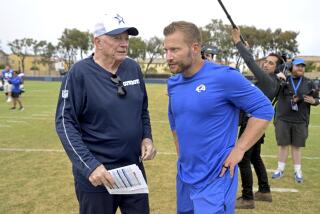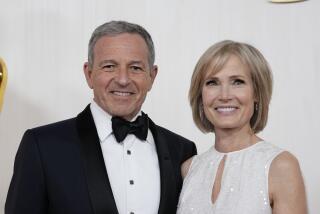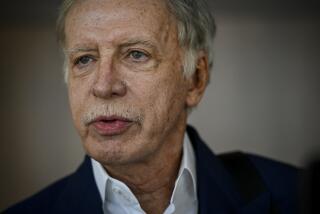NFL may have met its match in AEG owner Phil Anschutz
National Football League, meet your worst nightmare: a potential team owner who can call his own shots.
Or wasn’t that the signal flashed last week by Phil Anschutz, 100% owner of AEG and master of the downtown football stadium site that the league has been weaseling over for two slap-happy years?
In an interview with my colleagues Marla Dickerson and Mike James following the announcement that he is taking AEG off the sales block, Anschutz declared that if the NFL intends to locate a team near the downtown L.A. Live district owned by Anschutz’s firm, the league must come to him. He set his minimum terms: He must have an investment in both the stadium and the team “if they’re going to be occupying … the middle of our campus.”
He said that he’s “flexible,” but does any of that sound like he’s willing to be manhandled? (“We won’t be pushed into a deal,” he said.)
Is Anschutz bluffing? Keep in mind that he terminated the sale of AEG because no one would meet his price. The message to the bidders was, he doesn’t need your stinkin’ $7 billion; he can hold out for $10 billion.
The thought that the terminally arrogant NFL has finally met its match in a negotiating adversary is comforting, up to a point. Until now, the NFL has tended to deal with would-be owners and would-be venues that need the league more than the league needs them. And it hasn’t been shy about squeezing that imbalance of power until it screams for mercy.
Anschutz, however, has now let it be known that he’s not certain that pro football would be an unalloyed plus for his enterprise. AEG’s downtown entertainment venue, which includes L.A. Live and Staples Center, is “a big financial success,” he said in the interview. “There is some risk in plunking down a football stadium in the middle of that.... Will that hurt our Kings attendance? Will it impact our hotel attendance? Will it impact our [foot traffic] and our restaurants?” He added, “I came to the conclusion that it would be a plus, but not a given.”
If the league fathers don’t read that as: “You better have a good offer or we walk,” they should be in a different business.
Yet the downside of any talks between Anschutz and the NFL is that there’s no “given” that they won’t result in Los Angeles taxpayers getting stuck with a big bill. If a deal happens, Anschutz and the league will be in a position to press our political leaders for endless concessions.
How do we know this? We can extrapolate from their performance when AEG first unveiled the downtown stadium project in February 2011, with Mayor Antonio Villaraigosa and council members Jan Perry and Janice Hahn in attendance. To paraphrase Daffy Duck, what a revolting display that was.
“The second-largest city in America needs a football team,” Hahn proclaimed. “I say, let’s huddle.” There were inflated economic growth figures, fatuous dismissals of traffic problems and other environmental ills, talk of secret meetings between Villaraigosa and NFL Commissioner Roger Goodell. It was presented as if it were as good as a done deal — you would have thought they were already spreading fertilizer for the greensward. (At least, I smelled fertilizer.)
The city put the project on the fast track, hoping to shoulder aside a competing proposal from developer Ed Roski to build a stadium way out in the City of Industry. Now it turns out that Anschutz hasn’t even talked to the NFL for eight months. Furthermore, according to my colleague Sam Farmer, the league is claiming to be not happy with either the AEG or the Roski plan.
This should be the closing number of the NFL’s cabaret in Southern California. To sum up, respectable business enterprises in this community have presented the league with two choices: an urban stadium and a suburban stadium. One placed in the heart of an established, profitable entertainment district, and one around which an entirely new entertainment complex can be erected from scratch, possibly with the league’s participation. The California Legislature has been suborned into rewriting state law to give both these projects the legal right to run roughshod over their neighbors and the environment.
Anschutz has spent, by his accounting, between $45 million and $55 million of his own money to push the downtown project along. City officials have been herded, like cattle to the abattoir, into pledging to do everything in their power to get the stadium built — though not with a dime of taxpayer funds, wink wink.
One would think that in exchange for these bennies the league would have been moved to deal with Los Angeles, its business community and its residents with good faith and transparency. Instead, it has offered the same unceasing tergiversations, with nary a clue about what would constitute a suitable deal. Well, not entirely no clue: Plainly the NFL wants a deal in which the taxpayers put up all the money for a stadium, and the league’s billionaires take all the profits.
Anschutz seems to have called the NFL’s bluff, but chiefly on his own behalf. He’s done city officials the favor of demonstrating that this project always amounted to a pig in a poke; he’s even showing them the “oink.” Good for him. He doesn’t need the NFL, and obviously the NFL doesn’t need a team in L.A. — a vacant location slot here is much too valuable to threaten cities elsewhere into kissing up to their local football teams, lest they decamp for the coast.
But let’s not rest easy. Should Anschutz and the NFL somehow come together, we’re in for a hard, and expensive, ride.
Michael Hiltzik’s column appears Sundays and Wednesdays. Reach him at mhiltzik@latimes.com, read past columns at latimes.com/hiltzik, check out facebook.com/hiltzik and follow @latimeshiltzik on Twitter.
More to Read
Inside the business of entertainment
The Wide Shot brings you news, analysis and insights on everything from streaming wars to production — and what it all means for the future.
You may occasionally receive promotional content from the Los Angeles Times.











